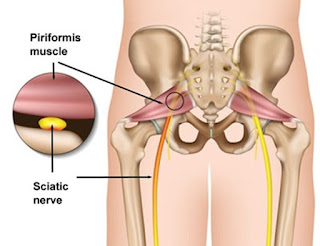Piriformis syndrome and corresponding sciatica disable 5.4 million Americans a year. Piriformis syndrome is a painful condition where the piriformis muscle, located in the buttock area, spasms and causes acute buttock pain. In addition to causing acute local pain, when triggered, the piriformis muscle can also irritate the nearby sciatic nerve, causing radiating pain, numbness and tingling along the back of the leg and into the foot.
There are several different circumstances that can lead to piriformis syndrome including:
- Muscle spasm: Due to the muscle formation in the gluts, the spasm may occur in the piriformis muscle itself, or be caused by irritation of a nearby structure such as the sacroiliac joint or hip muscles
- Over-tightening of the muscle, in response to exercise, injury or spasm
- Swelling and inflammation of the piriformis muscle
What is the Piriformis?
The piriformis muscle is a small muscle located near the hip joint behind the gluteus maximus in the buttocks. The piriformis is a stabilizing muscle that helps with balance, joint stabilization and performing movements like walking and running. The piriformis is used for most physical actions involving the hips and buttocks, so when it’s irritated, it can be extremely debilitating. Lifting, moving and rotating are all functions of the piriformis muscle which connects the lower spine to the tops of the thighs.
 Piriformis syndrome and sciatic nerve pain are often mistaken for each other and for good reason. The sciatic nerve passes through the piriformis muscle and they have similar functions in movement. The sciatic nerve actually runs down the back of the leg all the way to the feet. Both the piriformis and the sciatic nerve can be overused or sustain too much pressure leaving a person with symptoms of numbness, muscle spasms and chronic pain in the surrounding areas. Sciatic nerve pain differs from piriformis syndrome in that it can cause radiating pain and numbness in other areas. However, due to their proximity, it is possible to suffer from both simultaneously, requiring careful treatment to address both acute and radiating pain.
Piriformis syndrome and sciatic nerve pain are often mistaken for each other and for good reason. The sciatic nerve passes through the piriformis muscle and they have similar functions in movement. The sciatic nerve actually runs down the back of the leg all the way to the feet. Both the piriformis and the sciatic nerve can be overused or sustain too much pressure leaving a person with symptoms of numbness, muscle spasms and chronic pain in the surrounding areas. Sciatic nerve pain differs from piriformis syndrome in that it can cause radiating pain and numbness in other areas. However, due to their proximity, it is possible to suffer from both simultaneously, requiring careful treatment to address both acute and radiating pain.Who is at risk for Piriformis Syndrome?
- People who over-pronate (excessive rolling-in) their feet
- People who sit at a desk or drive for extended periods
- People with chronic or long-term subluxations of the sacroiliac joint
- People who run with poor posture and foot placement
Symptoms of Piriformis Syndrome
The most common complaint of piriformis syndrome is tenderness in the buttock itself, with shooting pain down the back of the thigh, calf and foot. Patients can also experience the following:
- Achiness in the muscles of the butt
- Pain with movement, particularly walking up stairs and inclines
- Inability to sit for extended periods without achiness or pain
- Reduced range of motion in the hips and legs
Because of the broad ranging symptoms and debilitating pain, it can take a careful coordination of pain-relieving modalities combined with therapeutic stretching and exercise to help reduce the symptoms of piriformis syndrome.
The Best Modalities to Treat Pain Associated with Piriformis Syndrome
- Ultrasound Therapy: The use of ultrasound therapy is actually recommended before stretching the piriformis muscle. The deep heating effect of ultrasound therapy helps to decrease tightness of the affected musculature and reduce irritation of the sciatic nerve itself. With acute piriformis pain, it is advised to use a smaller soundhead applicator (1cm or 5 cm) to give targeted pain relief, while a larger soundhead (5 cm or 10 cm) can be used to treat the entire gluteal and low-back region which may have tenderness and pain. For more, please read the Therapeutic Uses of Ultrasound Therapy Machines
- Cold Compression Therapy: Cold compression therapy devices come with corresponding back wrap was designed long enough to make it easy to administer this powerful modality to the piriformis region. Cold provides analgesic pain relief, while the compression helps flush out any swelling or inflammation that might be impinging on the sciatic nerve.
- Electrical Stimulation: Electrical nerve stimulation used in either transcutaneous electrical nerve stimulation (TENS) or Interferential Current Stimulator (IFC) mode can help block pain signals from piriformis syndrome from reaching the brain and stimulates the body to produce pain-relieving endorphins.
- Whirlpool Therapy: The piriformis muscle is located deep within the gluteal muscles, making it harder to reach with manual techniques. Using warm water whirlpool therapy can help relax the piriformis muscle, releasing any pressure that may be creating pain or impinging on the sciatic nerve.
- Therapeutic Exercise: Patients with piriformis syndrome will most likely think that rest will help reduce their pain. However, the opposite is true. Prolonged sitting or bedrest can actually make piriformis syndrome pain worse. What’s more, therapeutic stretching exercises that target the piriformis, hamstrings and hip extensors will actually reduce pain, relieve pressure on the sciatic nerve and improve range of motion in the hip joint. Here are two examples of stretches that are beneficial in treating piriformis syndrome:
- Knee pull: Have the patient lie on their back with both feet flat on the floor and both knees bent. Then have them pull in the right knee up to their chest, grasping the knee with the left hand and pulling it towards the opposite/left shoulder. Hold for 5 seconds to start. Repeat on the other side.
- Thread the Needle: Have the patient lie on their back with both feet flat on the floor and both knees bent. Have them bring the ankle of the right leg over the knee of the left leg, with the right knee bent out to the right side. Then, have them thread the right hand between the legs, while the left hand reaches around to clasp the right hand around the shin. Then pull the left thigh toward the chest and hold for five seconds to start. Repeat on the other side.
**These stretches are good for home exercise programs and can be repeated throughout the day as necessary. **
Treatment Note: When a patient has a profession that involves prolonged sitting, it can be difficult to completely eradicate the pain associated with piriformis syndrome. It’s important that patients implement a routine of standing and walking every 20 minutes. For patients with long commutes or who drive a lot for work, it’s important for them to make frequent stops when driving for extended periods to stand and stretch.
Our lifestyle is evolving to be more sedentary. Because of this, piriformis syndrome will continue to be a rising problem. It’s important for patients to seek rehabilitative treatment for piriformis syndrome, not only for the non-invasive pain-relieving modalities, but for the necessary education and tools that can help prevent recurrence.



It's a best article on Piriformis Syndrome with detail treatment and precautions. Physiotherapy is best treatment of these problems.
ReplyDelete